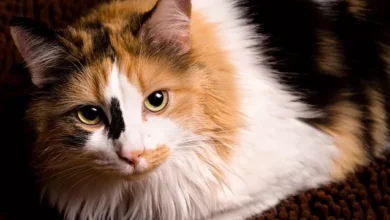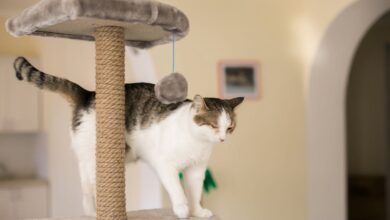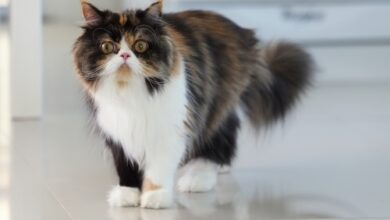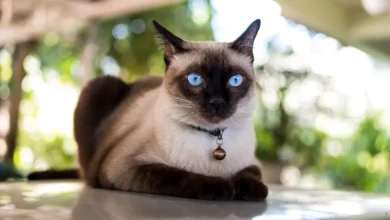The Mysterious and Majestic Norwegian Forest Cat
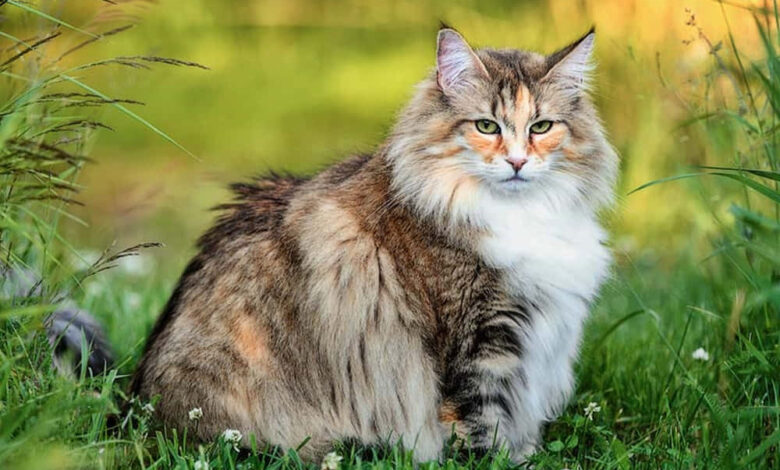
Frequently Asked Questions (FAQ)
Are Norwegian Forest Cats Friendly?
Yes, Norwegian Forest Cats are known for their gentle, easygoing temperaments, which are well-suited for families. Due to centuries of coexisting with humans in isolated Norwegian communities, they have a relaxed personality. As long as they properly socialized from a young age, Norwegian Forest Cats enjoy human interaction and bond closely with their favorite people through affection like purring, kneading, and nuzzling. They typically get along well with respectful children and other pets when introduced properly. That said, all cats have individual personalities, so thorough handling from a young age helps bring out their most sociable traits.
How Expensive Are Norwegian Forest Cats?
Purchasing a purebred Norwegian Forest Cat generally ranges from $800-$1500 or more from an ethical breeder. Higher prices indicate cats from lines that have been extensively health tested and show/working quality. Beyond the initial purchase, ongoing care costs should be budgeted similarly to other cats, including annual checkups, vaccinations, flea/tick prevention, and quality food appropriate for their larger size and activity levels. Over a 15+ year lifespan, total expenses for a Norwegian Forest Cat average a few thousand dollars, with many living into their late teens.
What Do Norwegian Forest Cats Eat?
As a large, active breed Norwegian Forest Cats have higher daily calorie and nutrient needs compared to petite house cats. A premium quality cat food formulated for adult cats and appropriately portioned weight/lifestyle management is recommended. Wet food 1-2 times per day, along with dry food available, is a balanced approach. High-quality proteins, fats, and limited carbohydrates fuel their energy. Treats can be given in moderation. Ensure fresh, clean water is available at all times as well. With their size and exercise needs, overfeeding obesity must be avoided.
Are Norwegian Forest Cats Talkative?
While not excessively vocal, Norwegian Forest Cats do communicate affectionately with their humans through various sounds. Expect periodic chirps, chattering, and trilling noises usually when greeting family members or seeking attention/affection. Some individuals may be more outspoken than others. They also purr heartily when contented! Rarely will Norwegian Forest Cats yowl or cry persistently like some breeds. Overall their vocal tendencies suit apartment living if not completely silent but enjoy purring as a bonding activity with their favorite people.
What are the health concerns for Norwegian Forest Cats?
As a generally healthy breed with no inherent genetic disorders, Norwegian Forest Cats have minimal known health issues when from reputable breeders. They are slightly predisposed to hypertrophic cardiomyopathy (enlarged heart) later in life, which modern preventative medicine can catch early. Other than occasional weight gain risks due to their size, Norwegian Forest Cats have an average lifespan of 10-15 years when cared for properly. Dental disease prevention through good nutrition, chew toys, and professional cleanings is also important, like any cat. With proper breeder screening and veterinary care, Norwegian Forest Cats have made dedicated companions for well over a decade.
Deep in the remote forests of Norway, a hardy breed of cat has lived and thrived for centuries. With its thick, water-resistant coat and strong build, the Norwegian Forest Cats has evolved to survive the harsh Nordic winters. Often called the “gentle giant” of cat breeds, this mysterious breed holds many secrets – and promises to make a loyal companion.
A Brief History of Survival Forest Cats
The exact origins of the Norwegian Forest Cat are unclear, but it is believed they share ancestry with cats that arrived in Europe thousands of years ago. Over generations of living amongst Norway’s untamed wilderness, they developed characteristics suited for the unforgiving climate. Their thick double coat protects against sub-zero temperatures and damp weather, while their large size and muscular build give them the endurance to hunt in deep snow.
Due to their remote habitat, the Norwegian Forest Cat remained relatively unknown to the outside world for many centuries. It wasn’t until the mid-20th century that breeders began organizing efforts to foster and promote the breed. In 1984, they were officially recognized by major cat associations like TICA and CFA. Today their population has expanded worldwide, though their heritage as hardy “forest cats” lives on in their appearance and personality.
Norwegian Forest Cat Personality
When seeking a new feline friend, personality is often among the top considerations. Thankfully, the Norwegian Forest Cat tends to have a very sweet, gentle, and loyal disposition. Due to centuries of human interaction in Norway’s rural communities, they have developed a relaxed, easygoing personality that is well-suited for family life.
Some key personality traits of the Norwegian Forest Cat include:
- Affectionate nature – They enjoy bonding closely with their favorite people and showing affection through nuzzling, kneading, and purring.
- Even temperament – Due to their calm demeanor, they usually get along well with children and other pets when properly socialized.
- Playful side – Don’t let the stoic appearance fool you! Norwegian Forest Cats enjoy interactive playtime and romping around with toys.
- Adaptability – While retaining instincts for independence, they adjust smoothly to most living situations, from apartments to houses.
- Gentle giants – Despite their larger size, Norwegian Forest Cats are not aggressive at all and prefer to resolve conflicts peacefully.
Overall, their personality tends to be easygoing yet alert – perfect for families seeking a lovable fluffball who also provides good company. Just be sure to socialize them adequately when young.
Norwegian Forest Cat Lifespan
When deciding on any pet, it’s important to understand its typical lifespan so you can make a long-term commitment. Fortunately, the Norwegian Forest Cat tends to live a lengthy and fulfilling life alongside their humans.
On average, Norwegian Forest Cats have a lifespan of 12-15 years when provided with good medical care and nutrition. Some impressive individuals have been known to reach 18-20 years of age as well! Compared to other cat breeds, this is well above average.
Their sturdy build and traits adapted for resilience in nature likely contribute to their longevity. As indoor pets, Norwegian Forest Cats also avoid many dangers in the outdoor environment that can shorten cat lifespans, such as accidents, infectious diseases, and predators.
With TLC, including an ongoing vaccination schedule, annual checkups, quality diet, and plenty of love – Norwegian Forest Cats can remain active companions into their golden years. Just be prepared for such a long-lived, cherished friend!
Norwegian Forest Cat Size and Weight
If you have visions of acquiring the typical petite housecat, then the Norwegian Forest Cat may surprise you with its substantial frame. This is a breed sized to withstand harsh Nordic winters, after all. On average, their dimensions are:
- Height: Males 13-16 inches, females 12-15 inches
- Length: 20-25 inches
- Weight: Males 9-18 pounds, females 6-14 pounds
However, weights may vary seasonally as their thick double coat comes and goes depending on the weather. During shedding seasons in warmer months, they typically lose a few pounds. At their heaviest in dense winter coats, Norwegian Forest Cats can approach or exceed the top end of weights listed above as well.
Overall, they are a medium to large cat size suitable for families with space. Kittens are smaller of course, but quickly develop a sense of their scale and strength. Be prepared for a cat who may dominate your lap versus fitting into it! Their stature also means more food intake to support a larger metabolism.
For those seeking an extra-large companion, know that Norwegian Forest Cats can potentially reach even larger sizes outside the breed standard guidelines in some lineages as well. Just be sure your home and lifestyle can suit such a substantial cat.
Norwegian Forest Cat vs Maine Coon
When researching Norwegian Forest Cats, another giant breed drawing comparisons is the Maine Coon. While both are large domestic longhair cats suited for colder climates, there are a few distinguishing qualities:
- Size – On average, Maine Coons tend to reach the absolute largest dimensions within breed standards at weights up to 25 pounds. Norwegian Forest Cats max out a bit smaller as “merely” very large cats.
- Coat – Norwegian Forest Cats have a dense, water-resistant double coat well-suited to repel wind and damp. Maine Coons have a softer, silkier single coat that is better for insulating body heat.
- Personality – Norwegian Forest Cats lean more toward a gentle, easygoing personality, while Maine Coons may exhibit slightly bolder, playful tendencies. Both breeds are affectionate with their families.
- Looks – Coat coloring in Norwegian Forest Cats shows strong tabby patterns and marks, while Maine Coons have a wider variety, including pointed, smoke, and colorpoint patterns.
- Origin – Norwegian Forest Cats originated amongst the remote fjords of Norway, while Maine Coons developed independently in New England, USA.
Overall, both are magnificent cats fitting larger homes. For those seeking the most substantial size potential, Maine Coons edge out their Norwegian cousins, while Norwegian Forest Cats offer a hardier coat matched to wet coastal climates. You can’t go wrong with either giant breed!
Tabby Norwegian Forest Cat
One of the most recognizable and beloved coat patterns found in cats is “tabby,” featuring distinctive dark stripes, lines, and swirls across the fur. The tabby pattern occurs naturally in about 70% of random-bred domestic cats worldwide.
For Norwegian Forest Cats, the tabby pattern is not only common but central to their breed type. In fact, the classic tabby variation is so dominant that any solid-colored Norwegian Forest is not eligible for championship status in major cat associations.
The specific tabby patterns seen include:
- Classic (blotched) tabby – Distinguished by dense, dark striped patterns that encircle the entire body like a ring.
- Mackerel tabby – Dark markings form straight vertical stripes much like a fish skeleton.
- Spotted tabby – Instead of continuous stripes, individual spots or marbling are dispersed across the coat.
Beyond coat characteristics, tabby Norwegian Forest Cats share all traits of the breed, like their size, personality, and adaption to cold climates. So if you are seeking the iconic tabby look along with a gentle giant breed, the Norwegian Forest Cat should be high on your list!
Disadvantages of Norwegian Forest Cats
While Norwegian Forest Cats offer many benefits as pets, no breed is perfect. Here are a few potential drawbacks new owners should be aware of:
- Grooming needs – Their dense double coat requires regular brushing to prevent matting, especially during seasonal sheds. Be prepared for tufts of hair everywhere!
- Larger size – As introduced earlier, Norwegian Forest Cats are medium-large animals requiring adequate living space. They also eat proportionally more food.
- Shedding – Year-round, their coat sheds to different degrees. Heavy seasonal shedding will blanket your home in fur despite brushing.
- Agility – Due to their weight, Norwegian Forest Cats are not as agile as some smaller breeds for climbing/jumping activities.
- Scarcity – As a rare breed, finding a Norwegian Forest Cat available from an ethical breeder takes time and effort versus popular breeds.
- Cold sensitivity – Although adapted to cold, indoor cats cannot handle extremely frigid outdoor temperatures safely in many parts of Australia.
Provided their needs are met, Norwegian Forest Cats make devoted companions. However, their size, coat, and scarcity are factors demanding extra commitment from adopters. Research breeds thoroughly before choosing.
